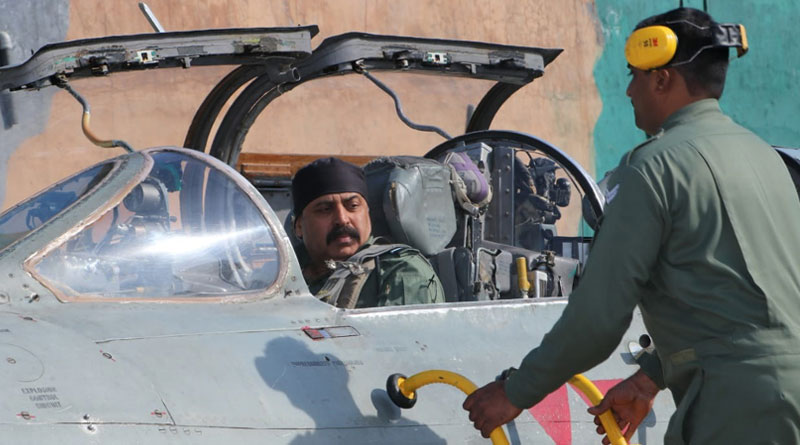UAVs are an ideal choice for retaliatory strike and should be considered for a hard-hitting action against enemy state
 Ajay Singh
Ajay Singh
On 14 February 2019 – Valentine’s Day – a Kashmiri youth Ahmad Dar slammed an explosive laden SUV into a Central Reserve Police Force (CRPF) convoy at Pulwama, killing over 40. It was the deadliest attack on Indian security forces and the smoking gun pointed directly to Pakistan.
Retaliation was swift. Just 13 days later on the night of 26 February, 12 Mirage 2000s armed with SPICE and Popeye precision munitions crossed the Line of Control (LC) and headed for Balakot in the Khyber Pakhtunkhwa province of Pakistan. They were part of a strike package supported by four Sukhoi 30s, Netra and Phalcon AWACS, a Heron UAV and two Ilushin -78 aerial refuellers. To act as a decoy, four other Sukhois had been launched towards Bahawalpur in South Punjab (deliberately flying high to be seen by Pakistani radars). The low flying formation of Mirages roared into Pakistani airspace undetected, acquired their target and loosened their munitions onto it.
The Jaish-e-Mohammed (JeM) camp at Balakot (the Markaz Syed Ahmad Shaheed Camp to use its real name) was on the crest of a ridge called Jaba Top. Spread over eight acres of land, it contained ten major buildings. Five SPICE bombs struck their target at around 3.45 am – a time which ensured maximum surprise. Three hit the main residential complex where around 80-100 recruits were reportedly staying, another hit the main building which housed the core leadership and the fifth hits the trainers’ complex. The entire strike took just eight minutes and by the time Pakistan fighters took off to intercept them, the Mirages were back in Indian airspace.
The jury is still out as to the effect of the strike. Indian sources claim that around 100–150 militants were killed, while the Pakistanis maintain that the casualties were restricted to just ‘some trees and a crow’. The exact damage would be someplace between the two conflicting claims. But then the casualties are not significant. What matters is that the message was sent out. The message that the LC and International Border (IB) were not inviolable and that a Pakistan-sponsored terrorist strike could meet a punitive response, unlike the timid and legally bound reactions which followed earlier attacks such as the Mumbai attacks of 2008.

The drama spilled over the next day when Pakistani fighters entered Indian airspace and in the dogfight that followed, a MIG 21 and a F-16 were shot down. The downed pilot Wing Commander Abhinandan Varthaman was returned the next day, but to date, the Pakistan Air Force (PAF) stoutly denies the loss of any of their aircraft (in fact, they maintain that it was a MiG 21 and a Sukhoi that were shot down). Unfortunately, it is a view propagated by much of the world media and the Indian Air Force (IAF) has not been able to convince the world community on the shooting down of the PAF F-16. The war of perception in the aerial battle has unfortunately gone to Pakistan.
Even more damning was the revelation that the MI-17, which had crashed at Budgam airfield on the day of the aerial clash, had been actually shot down by our own air defence. It was a tragic case of blue-on-blue and the needless loss of six lives was the worst outcome of the battle. Initially touted as an accident, it was formally acknowledged as a case of mistaken identity in the fog of war only last June.
The Lessons of Balakot
The strike at Balakot undoubtedly conveyed a clear and unambiguous message to Pakistan, which perhaps has contributed to the fact that there has been no major terrorist strike since then. But from the strike and the aerial battle that followed, the right lessons must be taken home.
One of the reasons for the loss of Abhinandan’s MiG-21 was that communications from the Air Traffic Controller (ATC) were blocked by Pakistani jammers, bringing out the importance of ECM suites in all aircraft. The loss of the MI-17 brings out glaringly the need for fully functional Identification Friend or Foe (IFF) at all times. These issues would have been addressed at the operational and tactical levels but there is much more that needs to be done.
The concerns of the IAF, especially in terms of its aircraft inventory, need to be urgently addressed. It is down to 30 squadrons when at least 42 are required to counter Pakistan and China. Its ageing fleet of MiG-21s, need to be replaced by top-of-the–line fighters that match or surpass their adversaries. The only silver lining has been that the first Rafale fighter was taken over at Paris in October 19 and the first batch of four aircraft will touch down at Ambala airbase in May. The remaining 32 will follow in batches till April 22 and it would go a long way in modernising the fleet. Hindustan Aeronautics Limited (HAL) has also been finally contracted to provide 83 Tejas fighters for the IAF. Yet, even after the much-delayed contract is inked, it would take another three years for deliveries to begin – time in which attrition would have further eroded the IAF’s dwindling fleet.
Perhaps, we should focus on UAVs for retaliatory strikes such as this. It is significant that the IAF is exploring a swarm drone prototype called ALFA –S or Air launched Flexible Asset (Swarm), which are carried in canisters beneath a strike aircraft and can be released from a hundred kilometers inside own territory to be propelled to the target through small, electric motors. These can be used for a future Balakot type of mission with half the risk and without the ignominy of a dead or captured pilot should the mission suffer a setback.
Much water has flown through the Jhelum since the Balakot strike and the ground situation has changed considerably. The chest-thumping and jingoism that emanated from both sides has not quite subsided. All along the LC the ceasefire has broken down with over 3,700 violations in the last year itself. Cross-border firing takes place on a daily basis and Mortar and Artillery duels are a regular feature. Perhaps it is time for tempers to cool and get a measure of normalcy back into Indo-Pak relations. We must not forget that even after the Kargil War and the attack on Parliament, former Prime Minister Atal Bihari Vajpayee, put it all behind to restart talks with General Pervez Musharraf and get relations back on track. It is high time that both sides get back to talks and get some measure of normalcy in relations.
Yet, the stakes are much higher now than what it was a year ago. With the abrogation of Article 370 and the division of Jammu and Kashmir into two Union Territories of Jammu and Kashmir and Ladakh, India has taken a calculated risk which can either integrate Kashmir completely with India or make us lose the plot there altogether. While Article 370 had to go, the five months of clampdown that followed, the suspension of internet services and the arbitrary detention of leaders has ensured that Kashmiris will never view the measure favorably. It has also drawn world attention to Kashmir as never before. President Donald Trump offered to mediate, as did the United Nations Secretary General. China has been repeatedly calling for UNSC meeting on Kashmir and it will take immense diplomatic skill to stave the issue. Coupled with the Citizenship Amendment Act (CAA) and National Register of Citizens (NRC) that followed, it has put a question mark on India’s record of human rights and commitment to democracy. There are fears that once the restrictions are removed, Kashmir may erupt once again in a wave of protest that would be difficult to contain or to justify to the world community.

So, should there be another Pulwama type of attack, or worse, something on the lines of Mumbai 2008, what would our response be? Will there be a similar strike as at Balakot? There will be a difference this time. Pakistan will actually hope for a muscular response from India so that another ground or aerial confrontation between the two nuclear armed neighbours will draw world attention to Kashmir once again. It would enable it to raise the ante and promote the issue in forums such as the United Nations (UN), Organisation of Islamic Cooperation (OIC) and all else. Its stance could well find favour with China, Turkey, Saudi Arabia, Malaysia and other supporters and countering them would be difficult. Our response in case of another strike — which is quite likely in the future — would have to be considerably more measured and calibrated.
As we commemorate Balakot, we need to have a good hard look at the events of February 19. Balakot was a message all right – a military and political one – but it was not the unqualified success it is often made out to be. Its operational lessons – especially in the shooting down of our own MI-17 and the downing of a MiG 21 fighter need to be driven home and equipment and tactics refined. The political repercussions and the escalatory spiral of the strike also need to be re-evaluated. So that should there be a need of a similar response, it could be equally hard-hitting, and delivers both the payload and the message with little loss to ourselves.

